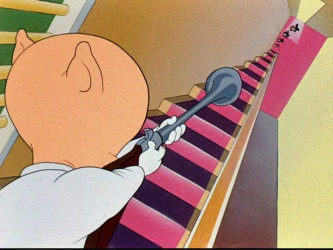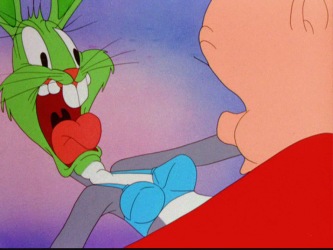The second wave of Looney Tunes DVDs – consisting of The Best of Bugs Bunny Volume 2, All Stars Volume 3, The Best of Tweety and Sylvester Volume 1, and The Best of the Road Runner Volume 1 – is now in Australian stores. The documentaries in these are much better than the first round, and the best of them is a solid twenty minute documentary on Bob Clampett. This, and the inclusion in this wave of several of Clampett’s best cartoons (including Porky in Wackyland, Kitty Kornered, The Great Piggy Bank Robbery, and A Corny Concerto) should help raise awareness of Clampett’s work. Clampett is much better known than he used to be, but there remains, I think, a huge discrepancy in the way in which his reputation has grown. Amongst animation buffs he now rivals Tex Avery and Chuck Jones as the most revered American animator outside of Disney, and yet he has never become a household name in the way that Jones, Avery or Friz Freleng have. In the wider popular consciousness, fate has conspired to leave one of the major Warner directors a relative unknown, and it’s well past time for a more widespread rediscovery of his work.
A number of factors combined to lead to this relative obscurity in the non-fan community. Perhaps most critically, Warner Bros. for many years lost control of its pre-1948 animation library, meaning that until the early 1990s, cartoons made before that date did not turn up on Warners-backed shows such as The Bugs Bunny Show. This meant that the work of earlier directors such as Clampett, Avery, Frank Tashlin, and Arthur Davis was massively under-represented on television during the period in which many discovered Warner Bros cartoons. Clampett died in 1984, just as interest in Warners animation was being stimulated by a generation of baby boomers who had grown up with the shorts: this meant that Friz Freleng and especially Chuck Jones were left as the elder statesmen of the studio, and the focus of the most media attention. It also didn’t help that Jones fell out with Clampett, and downplayed his importance. Jones pointedly left Clampett out of both the survey of Bugs Bunny’s “fathers” in The Bugs Bunny / Road Runner Movie (1979), and his discussion of other Warner directors in his autobiography Chuck Amuck (1989). The irony here is that the most likely reason for the resentment of Clampett was a perception that he was glory hound who had himself claimed too much credit in early interviews (such as this one, from Michael Barrier’s Funnyworld magazine). Voice artist Mel Blanc complained in his own autobiography that Clampett was an “egotist who took credit for everything.”
What this means is that if you grew up with the Warner cartoons of Jones and Freleng, but have never discovered Clampett, there’s a rich vein of great cartoons to catch up with. What’s more, the Clampett cartoons are, if anything, more representative of what the studio stood for: they really are the definitive Warner cartoons. The Warner Bros. cartoon studio built its reputation on its status as the “anti-Disney:” in contrast to the perceived sentimentality and ideological conformity of Disney animation, Warners cartoons are notable for their irreverence, wild humour, and sheer exuberance. Nobody’s cartoons epitomised that style more than Clampett – the best cartoons from Jones and Freleng are positively muted by comparison. Perhaps more importantly, though, Clampett helped create that style, whereas Jones and Freleng followed in the wake of other trailblazers. In the mid 1930s, when the Warners studio was just another second-rung turning out pale imitations of Disney’s work, the crucial move to start trying riskier material was made by two directors: Avery and Clampett. In 1937 Avery directed the first Daffy Duck short, with Clampett doing the crucial animation of Daffy. Clampett started directing later the same year, and in the last few years of the 1930s the directors effectively discovered the wilder Warners style. Avery would do his best work at MGM (his only really great Warners cartoon is A Wild Hare, the definitive Bugs Bunny short), but Clampett would stay at Warners until 1946, by which time he had led the studio well into its golden age. Chuck Jones was a peripheral figure in this first period of innovation: he was directing by 1938, but in these early years his work was slow, dull, and Disney-esque. He didn’t start consistently making funny cartoons until the second half of the 1940s, after Clampett had departed.
Effectively, then, there were two main phases of the Warners golden age: the early years (1937 to about 1946) in which the sensibilities of Avery and Clampett dominated, with Jones, Freleng, and Tashlin following their lead; and the later years (from about 1946 to the late 1950s) in which Jones came to be the dominant director, supported by Freleng and Robert McKimson. For the reasons I’ve already described the latter period is the one most people are familiar with, and these cartoons show the Warners style in its mature form: the directors know what they are doing, and do it well, but the cartoons lack the youthful exuberance of those from the earlier, less frequently revived years. Jones, in particular, was an impeccable director in his best period and deserves most of the praise heaped upon him. Yet he was an intellectually driven director who was highly analytical in his approach, and he never matched the freneticism and wild abandon that Clampett brought to his cartoons. Even today, with all the hyper-activity of modern electronic media, Clampett’s cartoons remain startling.
The Clampett philosophy is perhaps best stated by the sign that marks the boundary to the surreal landscape of Wackyland in Clampett’s early classic Porky in Wackyland: “IT CAN HAPPEN HERE.” In Clampett’s cartoons, anything can happen. This is not simply the comically motivated impossibilities that occur in typical Freleng and Jones cartoons (like Wile E Coyote or Sylvester surviving being blown up with dynamite). Instead, the world of Clampett’s cartoons is notable for its unmotivated, even threatening acts of craziness. Characters are often hysterical, infantile, aggressive, insane, or combinations thereof. His graphical style is defined by its emphasis on extreme, almost vulgar bodily shapes, and loose, free-flowing animation. Clampett took the kind of bodily distortion that most other directors would reserve for heightened “takes” and made them the norm. Where characters in other directors’ work have a “standard” look and then slip into carefully held key poses for comic effect, Clampett’s characters flow from one to another in a ceaseless mutation.
All this would be too much if Clampett was working in a longer format, but for a six-to-seven minute cartoon, what it brings is an exhilarating energy. Clampett’s cartoons are, quite simply, funnier minute-for-minute than pretty much any other animation ever made. A Corny Concerto (his send-up of Fantasia) is essentially two 3-minute shorts attached end-to-end, as programs in an Elmer Fudd-hosted concert feature, and each is as rich and satisfying as a full cartoon by another director. There isn’t ever any sense of pretension or self-consciousness about Clampett’s work: his cartoons are rapid-fire exercises in making the audience laugh.

Yet there is enormous thought behind them: looking at them closely, as the new DVDs allow you to do, you can see what an artist Clampett was. The design in them is very strong: he uses extreme angles, character poses and colour designs to increase the impact of shots or punctuate key moments. At some points, he has the characters play against featureless coloured backgrounds for dramatic effect. His framing and camera movement is consistently inventive, with very short shots (sometimes as brief as a few frames), whip pans, and extremely close or far shorts employed with enormous confidence. What distinguishes Clampett’s use of these devices is not so much that he does them in the first place, but how quickly he piles them on. Chuck Jones had a similar grasp of the language of film, and used many of the same effects Clampett did, but just as his character poses draw more attention to themselves, so too his visual flourishes are more calculated. When Jones uses an outlandish visual design, you are supposed to notice, but when Clampett does so, it comes and goes so quickly there is no time to think about it. This makes his technique all the more effective: there’s no time for appreciation, only gut-level reaction.
It’s impressive filmmaking by any standard: that it occurs in what were at the time under-appreciated throwaways is all the more remarkable. If you haven’t seen these films, you really owe it to yourself to check them out.
